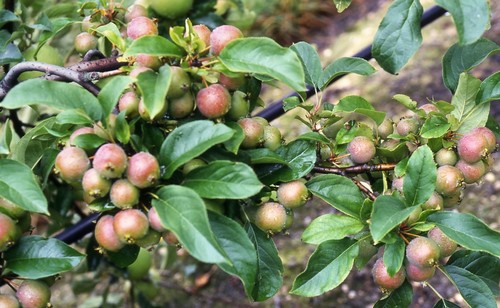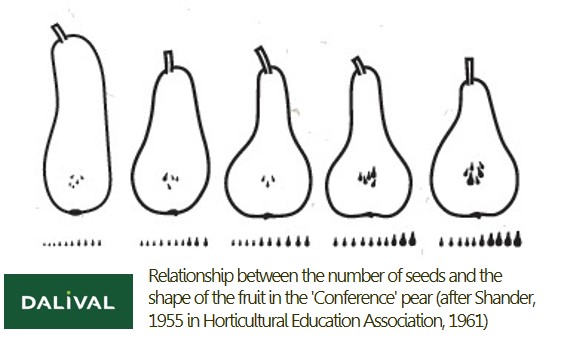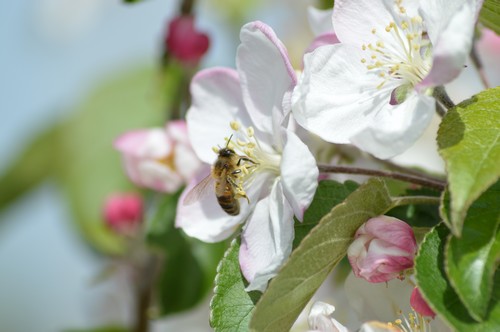 Nous contacter
Nous contacter
Advice
POLLINATING APPLE AND PEAR ORCHARDS
SOME THEORY ON POLLINATION
The basics
The formation of seeds and thus of fruit is the result of pollination.
Strictly speaking, the term “pollination” refers only to the transport of pollen, but it tends to include the result, which is the contact of pollen (from the stamens) with the pistil, and the germination of this pollen which fertilises the ovules contained in the pistil. The fertilised ovule develops into a seed and the tissue that develops around the seed forms the fruit.

Good pollination has an effect on the yield, but also on the size, shape and quality of the skin. It is imperative to have pollinator trees in the orchard to ensure the presence of compatible pollen at flowering time.

Cross-pollination and S-genotype
In most cases, the flowers of the same apple variety are self-incompatible and it is necessary to use another variety as pollinator.
Advances in genetic knowledge have led to a better understanding of the mechanism of cross-pollination.
In many plants that could morphologically be self-fertilised, genetic incompatibility systems favour or even require cross-pollination. This is due to incompatibility genes (S) existing in the form of numerous alleles (S1, S2, S3, …, Sx) that act on the development of the pollen grain on the stigma.
A variety is characterised by 2 alleles (for example, Granny is S3_S23). Partial compatibility between 2 varieties is when only one allele is different (e.g. Golden Delicious is S2S3, S3 is a common allele) and full compatibility when both alleles are different from each other (e.g. Braeburn is S9S24).
Braeburn and Golden have two completely different S-genotypes and common blossom times, so they are fully compatible and their combination will give optimal pollination.
The knowledge of the various S-genotypes makes it possible to optimise natural pollination between the trees in an orchard.

Attention: in addition to having compatible S-genotypes, to be able to pollinate each other, the varieties must have similar blossom dates.
Pollen germination capacity
Diploid varieties have a high pollen germination capacity (90-95%).
Triploid varieties have a very low pollen count (5-10%).
Belle de Boskoop, Reinette du Canada, Jonagold, Initial, Suntan are triploid varieties.
Malus are good pollinators for triploid varieties (see below).
All (non-triploid) varieties can be pollinators for another variety provided that :
- their pollen is of good quality,
- their respective dates of full flowering are within three days of each other (ideally the pollinating variety flowers slightly earlier)
- their S-genotypes are compatible or semi-compatible.
Pollen vectors
The main pollinating agents are honeybees (60-95% of the pollinating fauna).
To optimise pollination, it is necessary to introduce hives into the orchard, which should be brought in after the start of flowering (after the F1 stage) at a rate of at least 2 hives per hectare for apple trees and at least 4 for pear trees.
In order to optimise pollination, the hives should be oriented perpendicular to the rows of trees.

POLLINATING WITH FLOWERING APPLE TREES
The use of flowering apple trees (Malus floribunda) for orchard pollination was developed in France by INRAE in 1976.
Malus trees have several interests:
- Abundant flowering on different ages of wood, especially 1 year old wood and longer flowering time (10 to 15 days).
- Less sensitivity to alternation.
- Less susceptibility to diseases (interesting in organic)
- S-genotype is uncommon which allows better pollen mixing.
- Pickers are not likely to confuse the varieties.
- Low vegetation and medium space requirement (can be planted in place of a tree or interspersed).Strategic for triploid varieties.
For safety, it is advisable to plant 2 different Malus trees.
For more information on Malus trees, you can consult the sheet dedicated to them: https://www.dalival.com/advices/pple-pollinators-malus/

POLLINATING AN APPLE ORCHARD
OPTIONS FOR POLLINATING YOUR ORCHARD
When planting the orchard, there are several options for planting the trees: the single-variety block and the alternate row block.
The single-variety block
This option consists of planting a complete block of a single variety. Very efficient and practical for monitoring and cultivation operations throughout the season (thinning, pruning, harvesting, etc.), this solution is mainly used for so-called “self-fertile” and/or “diploid” varieties, which are rather easy to pollinate.
Beware of “triploid” varieties (such as Suntan) for which pollination needs to be reinforced.
The pollinators are positioned in staggered rows at a rate of 7 to 10% of the total number of trees depending on the variety, i.e. every 15-20 trees in staggered rows (see figures 1 and 2).
Ideally, 2 varieties of flowering apple trees and/or a variety known for its pollination capacity (e.g. Red Idared or Granny) should be chosen. In this way, the chances of pollination are increased, irrespective of the difference in flowering time between the different ages of wood on the trees.
The pollinators are placed either between two trees of the variety to be pollinated or in the place of a tree of the variety making up the block.
Note that below 0.8 m row density, it is always preferable to place the pollinator in the place of a tree so that the tree can develop sufficiently.


Alternate row block (4/2 or 4/1)
This alternative consists of placing 4 rows of one variety together with 1 or 2 rows of another variety that can pollinate each other (figure 3). This technique optimises pollen mixing within the orchard, while maintaining control over the cultivation operations to be carried out. In this case, it is advisable to add a few Malus trees (or pollinating apple trees) on the 2 inner rows of the 4-row block (up to 3% staggered).

Additional advice:
In addition to the above, it is particularly effective to position pollinators at each end of the rows: ideally 1 Malus and 1 tree of a pollinator variety (such as Red Idared which has pollen capable of germinating in low temperatures).
Many studies have shown that bees stop at the tree at the end of the row and have a certain continuity of foraging on the same row. This is even less of a loss of production as these end trees are often poorly protected by hail nets and are often caught by tractors with sometimes rather low steering angles. It will therefore be less damaging if only the end pollinator trees are damaged.
POLLINATING PEAR TREES
Pear trees flower earlier than apple trees.
Depending on the variety and weather conditions, it starts in April to mid-May and lasts between 6 and 20 days.
Most pear varieties are self-incompatible: two varieties must be cross-pollinated to produce fruit, although some varieties are incompatible (and this incompatibility is much stronger than for apples).
For example, Fred® CH201 and Harrow Sweet or Williams and Louise Bonne will not pollinate at all.
It is therefore important to choose the right pollinating variety.
Some examples of successful variety/pollinator pairs:
- Conference/President Heron
- Williams/Fred® CH201
- Comice/Conference
In order to optimise the pollination of pear trees in the orchard, several arrangements can be considered:
- Staggered: one pollinator tree for every 8 trees to be pollinated (10 to 12% pollinators). This is the most efficient method for pollination but not the most practical for cultural interventions.
- Block system: juxtaposition of monovarietal blocks every 2 to 4 rows. If there is a main variety, 2 rows of pollinators are interspersed. This method facilitates cultivation.
The pear tree also has the particularity of having so-called parthenocarpic varieties (like Conference). This means that they can produce fruit without fertilisation and therefore without pollination. The fruits produced are therefore seedless. These fruits are generally more elongated (see picture).

FLOWERING PERIODS OF OUR MAIN APPLE VARIETIES
Dalival (in collaboration with IFO and advised by La Morinière research station) has worked on the pollination of the varieties in its catalogue.
You will find here our tool to determine the pollinators for a variety.

FLOWERING PERIODS OF OUR MAIN PEAR VARIETIES
Harrow Sweet is the earliest variety, followed by Williams, then 2 to 3 days later by the other varieties Conference, Concorde, Comice, President Heron, Misty Rose® NC4).
You can find our pollinator determination tool for a variety here.


Archive of Pommoscopes
Request Quotation - POLLINATING APPLE AND PEAR ORCHARDS
 English
English Français
Français Deutsch
Deutsch Español
Español Italiano
Italiano Русский
Русский Polski
Polski






